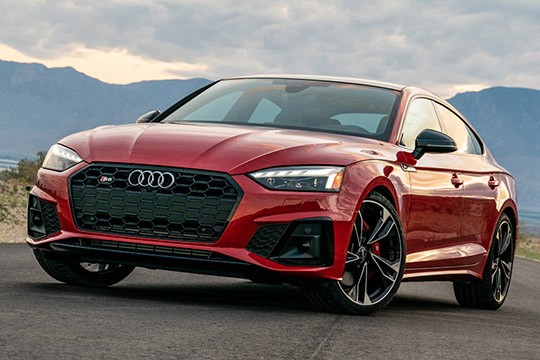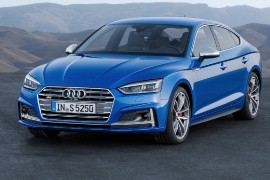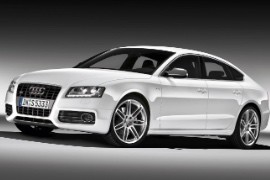AUDI S5 Sportback Models/Series Timeline, Specifications & Photos
First production year: 2010
Engines: Diesel, Gasoline
Audi unveiled the refreshed version of the second generation of the S5 Sportback in the fall of 2020, surprising its customers with the updates to the car’s exterior, interior, and drivetrain.
Despite the world pandemic that slowed the globe in 2020, Audi kept its promise and refreshed the second generation of the A5 lineup four years after the model’s introduction in the summer of 2016. Besides the regular versions, the car manufacturer also updated the S5 Sportback, which came with a bolder design and a more sophisticated interior. In addition, Audi made a surprising decision for the European market by installing a mild-hybrid turbodiesel drivetrain instead of the already-known TFSI powerhouse. However, U.S. customers could still get the car with the gasoline-fueled version.
At the front, the automaker’s design team made the hexagonal singleframe grille wider and flatter. It sported a honeycomb mesh pattern. Above it, the automaker placed a slim slit that resembled the mighty Audi Sport quattro from 1984. The redesigned headlights were LEDs as standard, with an option for Matrix LEDs. On the lower side of the wrapped-around plastic bumper, the 2020 Audi S5 Sportback had redesigned side scoops that housed the fog lamps and the parking sensors. In addition, they sported the vents for the air curtain that lowered the drag.
While the 2020 Audi S5 Sportback looked identical to its predecessor at first sight, the car manufacturer replaced all body panels but the roof. The creased lines were deeper, and the same went for the sculptured areas on the lower side of the doors. In addition, the automaker placed new aerodynamic side sills that reduced the ground effect. Another visual upgrade was for the wheels, which were available with up to 20-inch in size. At the back, the ducktail on the tailgate looked more prominent. Underneath the bumper, regardless of the engine variant, the five-door hatchback still had the same quad-exhaust system.
Inside, customers were greeted by an updated dashboard. It featured horizontal lines that emphasized the car’s width. Fronting the driver was the Audi Virtual Cockpit, featuring a 12.3-inch display with 1920x720 px resolution, which looked sharper. At the same time, atop the center stack, the automaker replaced the formerly-used 8.3-inch display for the infotainment system with a 10.1-inch one. Just like its predecessor, the 2020 Audi S5 Sportback had high-bolstered front seats with an option for a pair of bucket seats sporting the S5 logos embroidered on their seatbacks.
Under the hood, the gasoline-powered version received a 349 hp (354 PS) three-liter turbocharged V6 unit. The automaker paired it with an eight-speed automatic transmission with a torque converter that sent the power in all corners. On the other hand, European customers could get the 2020 Audi S5 Sportback with a three-liter mild-hybrid turbodiesel powerhouse. Despite being an oil burner, the German car manufacturer managed to squeeze 347 PS (342 hp) from the V6 TDI unit. It was helped by a water-cooled belt alternator starter (BAS) that could generate up to 8 kW (11 hp) and 60 Nm (44.3 lb-ft) of torque. The 3.0-liter TFSI (gasoline) unit could rocket from naught to 60 mph (0-97 kph) in 4.5 seconds. At the same time, the oil-burner version could sprint from 0 to 100 kph (0-62 mph) in 4.9 seconds.
Besides the coupe and the convertible, the second generation of the Audi S5 Sportback debuted in the fall of 2016, adding more practicality to the German hatchback-styled compact sports car.
Mercedes-Benz polarized the market when it brought back the four-door coupe shape with the first generation of the CLS. But then, other automakers started to do similar vehicles. Furthermore, Audi made its own versions of a four-door coupe, the A5 and the A7, and both were successful. In 2016, the four-ring automaker unveiled the second generation of the A5, which was built on the same MLB platform used by other cars within the Volkswagen Group. But customers were waiting for the punchier version of it, the S5. The car was available in three body shapes: coupe, cabriolet, and hatchback. The latter version was the one that could provide enough cabin space for a family and still perform like a sports car on the road thanks to its potent engine, the tuned suspension, and the eight-speed automatic S-Tronic transmission whose changes were blistering quick and made the six-speed manuals look like they were from the Dark Ages.
Besides any technical argument, the German car manufacturer from Ingolstadt convinced its customers to buy the A5 due to its fresh look. The 2017 Audi A5 Sportback had a front fascia expressing power and performance. Its angular-shaped LED headlights (Xenon Plus for the U.S. market) sported F-shaped daytime running lights on its upper area, looking like angry eyebrows. They flanked Audi’s specific singleframe grille adorned with horizontal slats and wore the red and silver S5 badge. The four-ring badge took center stage and looked sculpted, not applied. On the lower side of the wrapped-around plastic bumper, the automaker placed a pair of side scoops that housed round fog lamps.
From its profile, the coupe-shaped vehicle boasted flared wheel arches on both ends. A creased and waved line that stretched from head to tail, crossing the doors, visually connected the headlights to the taillights. In addition, the 2016 Audi S5 Sportback had a lower sculptured area on both doors in an ascending shape that gave the car a dynamic look. Furthermore, the low-slung greenhouse featured a raked windshield followed by a curved roofline and ended with a sloped-down tailgate. Unlike the S5 Coupe, the Sportback was half-coupe and half-hatchback. At the back, Audi didn’t cut any corners and placed the wide LED taillights shared by the rear quarter panels and the tailgate. In addition, below the bumper, the S5 boasted a set of four oval exhausts with chromed tips. It was the only part of the car, besides the badges, that confirmed the vehicle’s performance-oriented status.
Inside, customers found a luxurious and sporty cabin. The high-bolstered front seats adorned by embroidered S5 logos on their seatbacks promised firm support for their occupants during high-speed cornering maneuvers. Furthermore, the dashboard was covered in soft materials and could be decorated with aluminum or carbon fiber trims. Atop the center stack, the 2016 Audi S5 Sportback had the 8.3” screen of the infotainment system, which was available with an Internet connection and live map updates. Furthermore, it featured Apple CarPlay and Android Auto. Those seated in the back shared a split-folding (40/20/40) bench seat that could expand the trunk space from 480 liters (17.0 cu ft) to 1,300 liters (45.9 cu ft). Fronting the driver was a 12.3-inch color display for the digital instrument cluster named Audi Virtual Cockpit.
Under the hood, like its predecessor, the 2016 Audi S5 Sportback had a three-liter V6 engine. Unlike that, though, the new unit was helped by a twin-scroll turbocharger instead of a compressor. As a result, power went up by 20 ponies compared to that one for a total of 354 PS for the European market or 333 hp for U.S. customers. The automatic transmission sent the power in all corners via a standard all-wheel-drive system featuring a Torsen center differential.
While the world financial crisis still affected markets, Audi dared introduce a facelifted version of the A5 lineup at the 2011 Frankfurt Motor Show, and along with the rest of the range, it also unveiled the S5 Sportback.
Revealing an expensive four-door coupe with a sporty feeling and a family-oriented cabin didn’t seem the best idea in 2011, but Audi dared to do that. It considered that the S5 Sportback was the right choice for someone who liked sports cars but needed a family vehicle. It was the correct answer for those who couldn’t afford two cars to haul everyone around and still be engaging to drive on a winding road. In addition, the 2011 Audi S5 Sportback came with significant visual upgrades and important interior changes to make it more appealing for the fans of the four-ring brand.
When Audi unveiled the facelifted version of the A5 lineup, the changes made to the front fascia were so massive that some people believed it was a new generation. The updated model had angular-shaped headlights instead of rectangular ones, and they sported LED daytime running lights that framed the Xenon headlamps. In addition, the singleframe grille was altered and featured beveled upper corners. In addition, the four-ring badge looked sculptured, not applied to it. On the lower side of the bumper, the 2011 Audi S5 Sportback had redesigned side scoops that looked slimmer and wider and housed rectangular fog lamps instead of round ones like the non-facelifted version.
The first generation of the S5 Sportback looked understated. Only someone who could notice the V6T badges on the front fenders could understand that the car was more than just a vehicle made for regular school runs and weekly shopping. However, the standard 18-inch cast aluminum wheels were specific to the S5 model. Like its predecessor, the car could be optioned with silver door mirror caps but body-colored handles. To make the 2011 Audi S5 Sportback look more dynamic, the automaker added sculptured areas that followed an ascending line on the lower side of the doors. At the back, the redesigned LED taillights sported smaller reversing lights instead of upper mounted, but they kept their overall shape. Finally, under the rear bumper, the car revealed its true capabilities since it exhaled through four oval exhausts that flanked the rear diffuser.
Inside, Audi installed standard high-bolstered seats at the front with manual adjustments, but customers who craved more could order the 2011 Audi S5 Sportback with sports bucket seats. Atop the center stack, the automaker installed a new 8.3-inch infotainment screen for the MMI (Man-Machine-Interface) infotainment system. Its four buttons and the dial that controlled it found their place on the center console. Like most other four-door coupes on the market, the bench seat in the back could be folded flat and expand the 480 liters (16.95 cu ft) to a respectable value of 980 liters (34.61 cu ft).
Under the hood, Audi installed the same three-liter V6 supercharged engine as on the previous version of the S5 Sportback. Despite the fact that customers asked the automaker to introduce a six-speed manual transmission, the four-ring brand from Ingolstadt kept the same seven-speed automatic (dual-clutch) gearbox as the only option. However, the all-wheel drive system was enhanced, featuring a crown gear in the center differential that smoothened the torque transitions from the front axle to the rear.
Audi introduced the five-door version of the S5 Coupe in 2009 at the Frankfurt Motor Show, convincing customers that a car suited for a family could still look like a coupe.
Dressed like a coupe and based on the same platform as the Audi S4, the 2010 Audi S5 Sportback was the German automaker’s unusual answer in the sports sedan segment. While it still produced the S4 sedan, the Sportback was different thanks to its four-door coupe shape and frameless windows typical for two-door sports cars. However, unlike its two-door stablemate powered by a naturally-aspirated 4.2-liter V8 powerplant, the S5 Sportback was provided with a supercharged three-liter V6 engine. In addition, even though it wasn’t slow, it was not available with a row-your-own gearbox, so customers had to rely on the two-pedal version. But at least it had a pair of paddles behind the steering wheel to manually select the desired gears.
At the front, the car had the same rectangular headlights as its non-S sibling, featuring pearls-like LED daytime running lights on the lower side. In the middle, the 2010 Audi S5 Sportback featured a massive reversed trapezoidal singleframe grille, typical for Audi. To make it stand out from the crowd, the automaker adorned it with seven chromed vertical slats and added the tiny red and silver S5 badge on the left area, just above the license plate holder. Lower, on the apron, Audi installed a pair of side scoops that housed the round fog lamps.
The credits for the first recognized four-door coupe in history went to the 1962 Rover P5 Mark II, but that vehicle went down in history. But still, it left a trace, and Mercedes-Benz revived that shape in 2004 when it introduced the first generation of the CLS. Soon, other car manufacturers followed the trend, but Audi did it differently. Its first four-door coupe was the 2009 Audi A5 Sportback, which featured a fastback shape resembling other glorious vehicles from the brand’s history, such as the mighty Audi Coupe of the early ‘80s. The S5 Sportback looked understated. Only a keen eye for detail could spot the V6T badges on the front fenders. However, the large 18-inch alloy wheels couldn’t pass unnoticed by any car enthusiast. At the same time, the back of the vehicle revealed a set of taillights stretched from the rear quarter panels onto the tailgate. Audi installed an exhaust system with four chromed oval pipes under the rear bumper to make the vehicle look and sound even sportier.
Inside, Audi didn’t spare any effort when it created the cabin of the 2010 Audi S5 Sportback. The low dashboard featured an eight-inch color display for the infotainment system placed atop the center stack. Users could control it via a dial and several buttons on the center stack. The bolstered front seats were standard, while a pair of bucket seats with embroidered S5 logos on their seatbacks was on the options list. In the back, the car manufacturer added a split-folding (60/40) bench seat that could expand the trunk space from a decent 480 liters (16.95 cu ft) to a respectable value of 980 liters (34.61 cu ft). Fronting the driver was a rounded-shaped instrument cluster filled with two large dials for the speedometer and the tachometer, placed in individual clusters in a binocular style.
Under its hood, the 2010 Audi S5 Sportback carried over the supercharged engine placed on its open-top brother, the S5 Cabriolet. The automaker paired it with a standard seven-speed S-Tronic gearbox that sent the power in all corners via a Torsen center differential. Unlike the coupe version, the Sportback model was not available with a six-speed manual.



